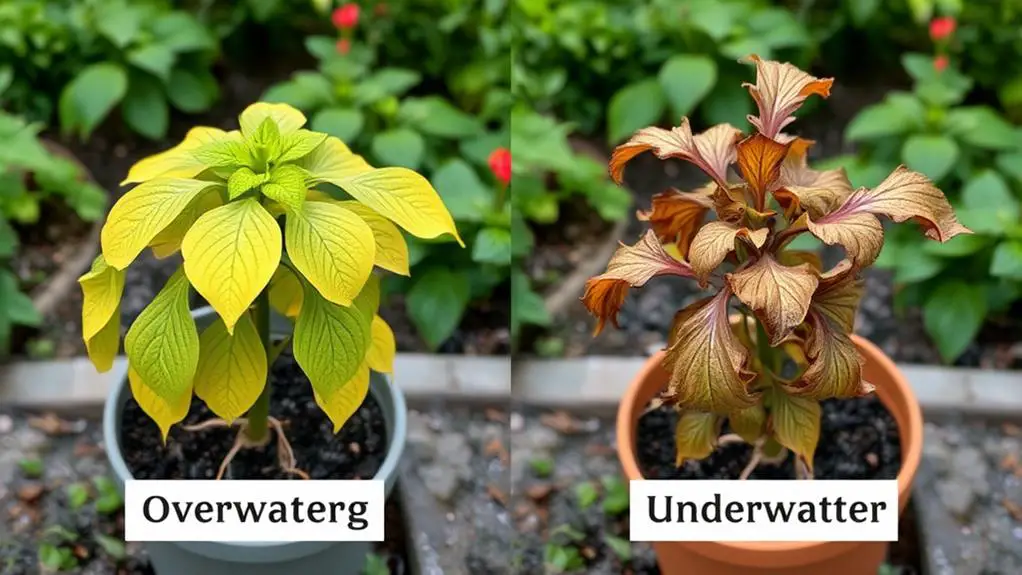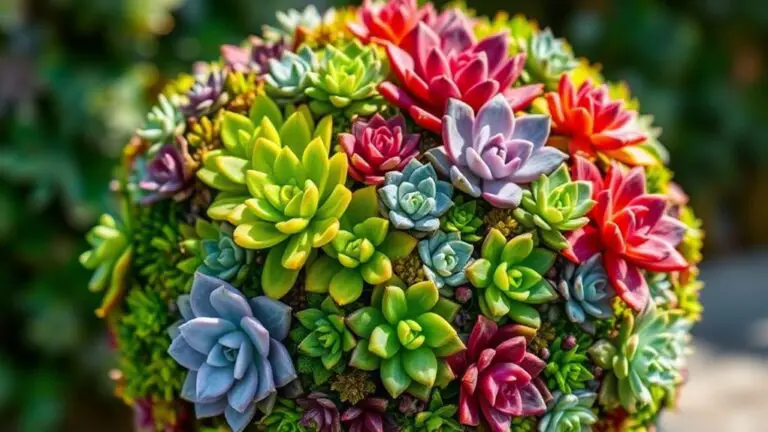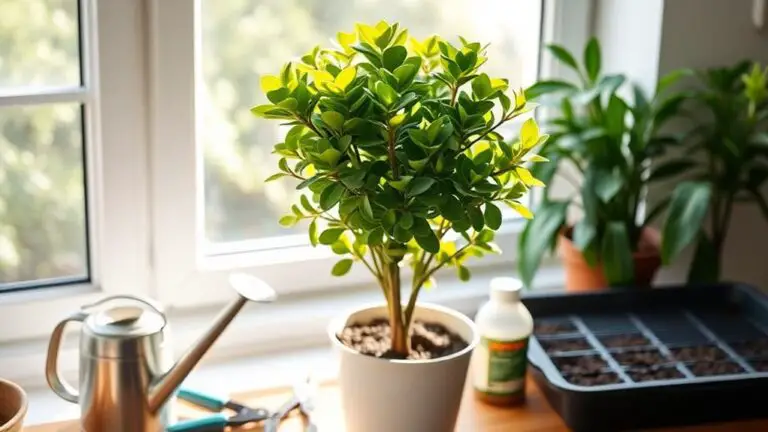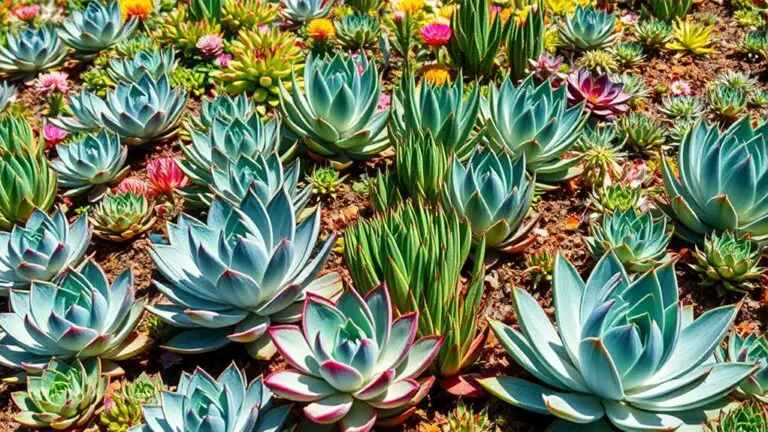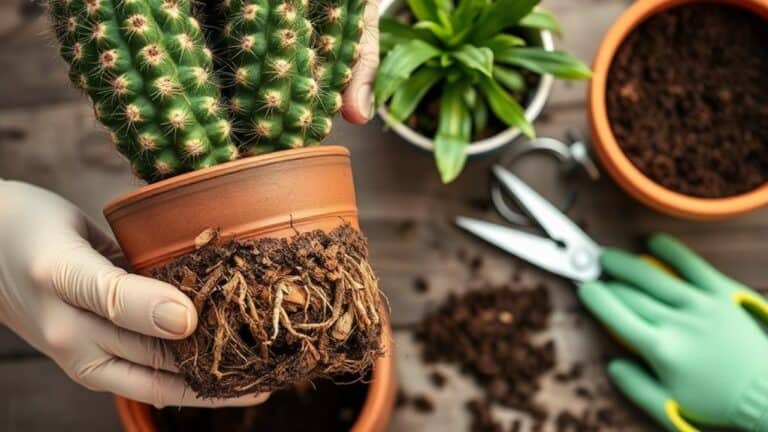7 Signs of Overwatered Vs Underwatered Plants
When caring for your plants, it's crucial to distinguish between signs of overwatering and underwatering, as both can lead to significant issues. You'll notice that yellowing leaves, wilting, and soil condition are key indicators, but how do you tell one problem from the other? Overwatered plants often have a distinct set of symptoms, while underwatered ones show different signs. By understanding these differences, you can better manage your watering habits and guarantee healthier plants. So, what exactly should you look for to diagnose these common issues?
Yellowing Leaves
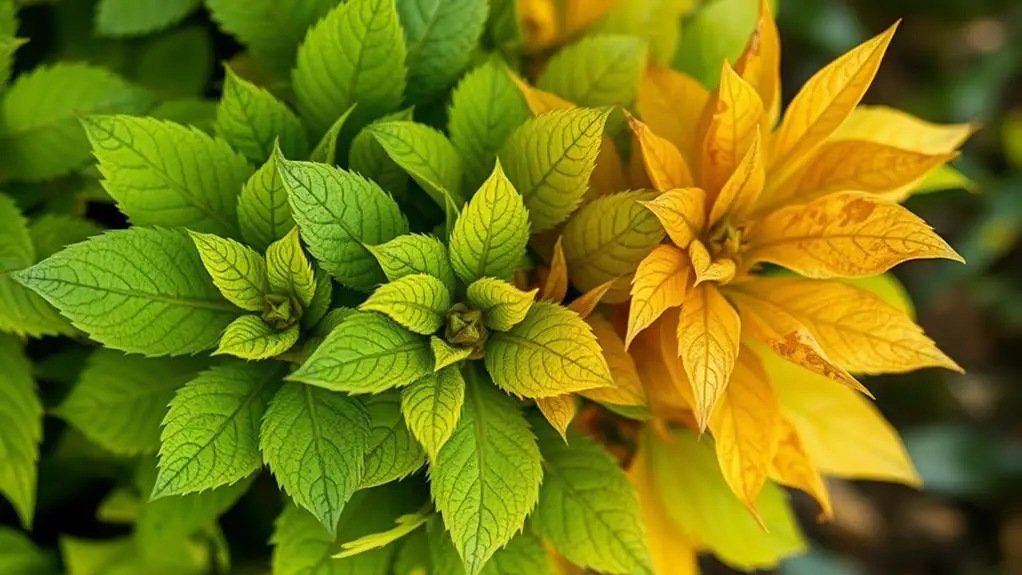
Yellowing leaves are a clear indicator that something's wrong with your plant's watering routine. If you notice yellow leaves, it could mean your plant is either overwatered or underwatered.
Overwatered plants often show yellowing that starts from the tips and edges. These leaves become limp and soft due to excess moisture, which can lead to root rot. The signs of overwatering also include widespread yellowing, especially in younger leaves.
In contrast, underwatered plants usually exhibit yellowing in the lower leaves. These leaves may curl or become crispy as the plant tries to survive with limited water. The yellowing is often localized to older foliage, and the leaves turn dry and brittle.
To determine whether your plant is overwatered or underwatered, check the soil moisture. Soggy soil indicates overwatering, while dry, compacted soil suggests underwatering. Both conditions can lead to yellowing leaves.
Wilting
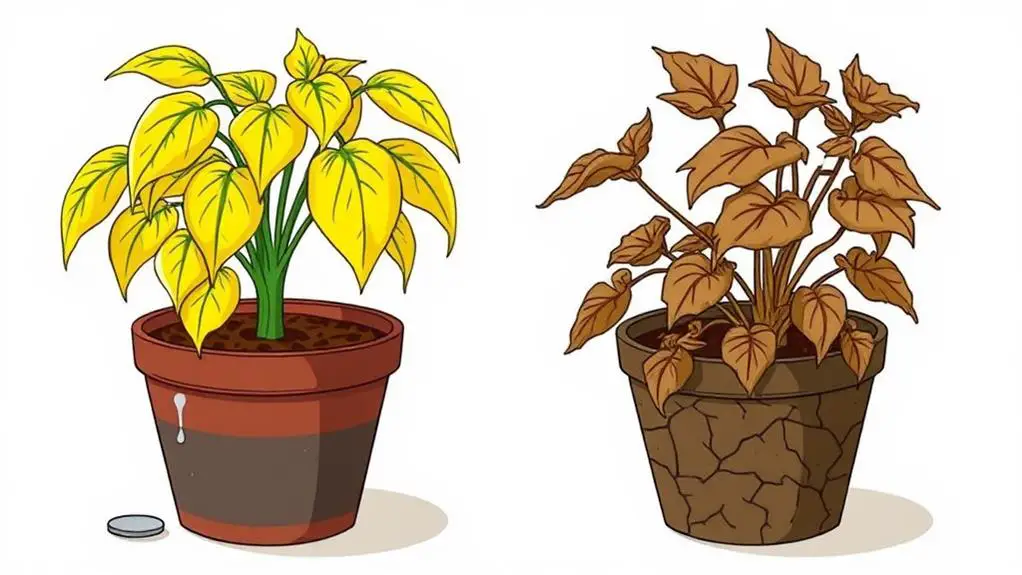
Wilting is another clear sign that your plant's watering habits need adjustment. When plants wilt, it can be tricky to determine whether they're overwatered or underwatered. Evaluating soil moisture is key to pinpointing the issue.
For overwatered plants, wilting often persists despite additional watering. This wilting results from root suffocation and possible rot, leaving the plant unable to absorb water.
In contrast, underwatered plants show wilting with dry, crispy leaves and usually perk up within hours after receiving water.
To differentiate between overwatering and underwatering, pay attention to these signs:
- Limp and mushy leaves suggest overwatering.
- Dry and brittle leaves indicate underwatering.
- Soil moisture: Check if the soil is soggy or dry.
- Pot weight: Lighter pots often mean underwatering, while heavier pots may point to waterlogged soil.
- Immediate response: Underwatered plants typically improve quickly after watering.
Leaf Texture
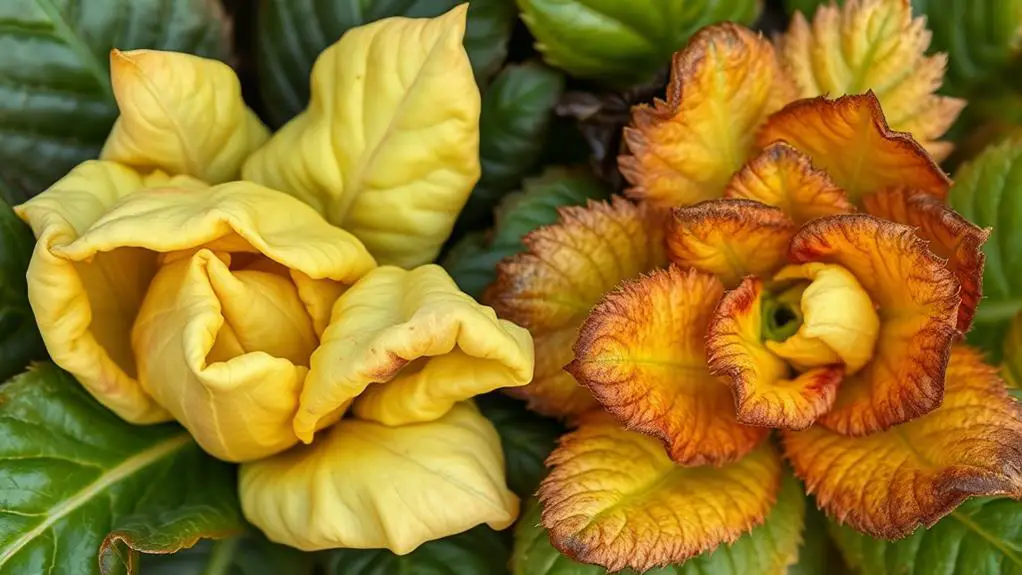
Leaf texture can reveal a lot about your plant's watering needs. When a plant is overwatered, its leaves often become soft and limp. They might even feel mushy or pruney, which is a clear signal that the roots are rotting from too much moisture.
You may also notice blisters or lesions on the undersides of the leaves, indicating that excess water pressure has caused the cells to burst. These signs of overwatering should prompt you to reduce your watering frequency and improve drainage.
On the other hand, underwatered plants tell a different story through their leaf texture. You'll find the leaves dry and crispy, especially around the edges. This dryness means the plant is dehydrated and its cells lack sufficient water.
The leaves may also appear lightweight and brittle, a stark contrast to the heavy, limp leaves of overwatered plants.
Soil Condition
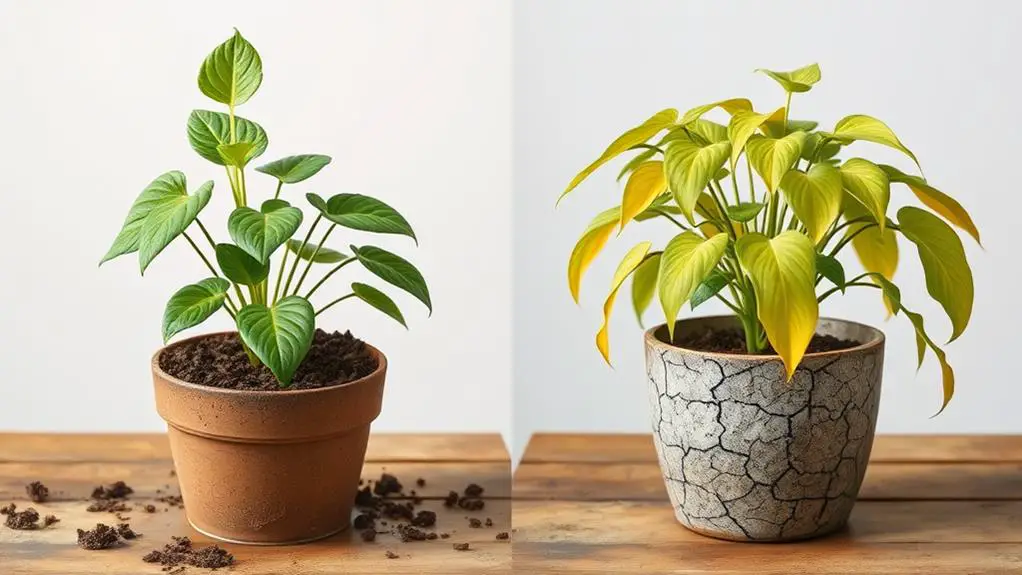
When checking soil condition, you'll notice that overwatered soil stays wet, often leading to a moldy smell, while underwatered soil looks dry and may pull away from the sides of the pot.
You can use simple tests like sticking your finger into the soil or using a moisture meter to see if it's soggy or dry.
Consistently monitoring soil moisture helps you avoid the extremes of root suffocation from soggy soil or hard, compacted soil that prevents water from reaching the roots.
Soil Moisture Levels
Understanding soil moisture levels is essential for maintaining healthy plants. Whether you're dealing with overwatering or underwatering, knowing how to check the soil moisture effectively can make all the difference in plant care.
Overwatered plants often sit in soggy soil, leading to root rot, while underwatered plants reside in dry, compacted soil, causing stress and wilting.
To maintain proper soil moisture levels, you can:
- Perform the finger test: Insert your finger into the soil up to 2 inches deep. If the soil feels wet, you might be overwatering. If it's dry, your plant likely needs a drink.
- Use a moisture meter: This handy tool provides accurate readings of the soil's wetness, helping you avoid excess water or dry conditions.
- Observe the leaves: Leaves that feel soft and mushy might indicate overwatering, while crisp, dry leaves suggest underwatering.
- Check soil weight: Heavy, wet soil points to too much water, whereas lightweight, crumbly soil signals a need for hydration.
- Regularly monitor moisture: Consistent checks prevent prolonged dry or overly wet periods, ensuring your plants remain stress-free.
Soil Texture Changes**
Noticing changes in soil texture is a vital step in diagnosing whether your plant is overwatered or underwatered. When soil is overwatered, it often feels consistently soggy and muddy. This indicates poor drainage and high moisture levels. You might even see mold or algae on the surface, showing that the environment is too moist. This soggy soil can become waterlogged and anaerobic, harming your plant's health.
On the other hand, underwatered soil typically appears dry and can pull away from the edges of the pot. This results in a hard, compacted texture that makes it difficult for water to penetrate. The soil may feel gritty and loose because the lack of moisture causes soil particles to clump together less effectively. This kind of soil becomes hydrophobic, meaning it repels water, making it hard for plants to absorb what they need.
Evaluating these soil texture changes is fundamental. By understanding the differences between soggy, overwatered soil and dry, underwatered soil, you can adjust your watering habits to better meet your plant's water needs.
This helps guarantee your plants thrive with the right balance of moisture and drainage.
Plant Growth

Healthy plant growth hinges on striking the right balance in watering. When you overwater your plants, you risk stunted growth because excess moisture can suffocate the roots. Without sufficient oxygen, your plant can't produce the energy it needs.
On the other hand, underwatering forces plants to conserve water and energy, which slows down their growth and results in fewer new leaves.
To help you understand better, here's what you might notice:
- Overwatered plants: They often show stunted growth and may develop root rot, which further hampers their ability to absorb water and nutrients.
- Underwatered plants: These plants usually have dry, crispy leaves, making it hard for them to photosynthesize and grow.
- Soil check: Consistently wet soil can be a sign of overwatering, while dry, crumbly soil suggests underwatering.
- Leaf color: Yellowing leaves can indicate both overwatering and underwatering, making it essential to check soil moisture.
- Water management: Proper watering practices are vital to maintaining plant health and avoiding long-term growth issues.
Root Health
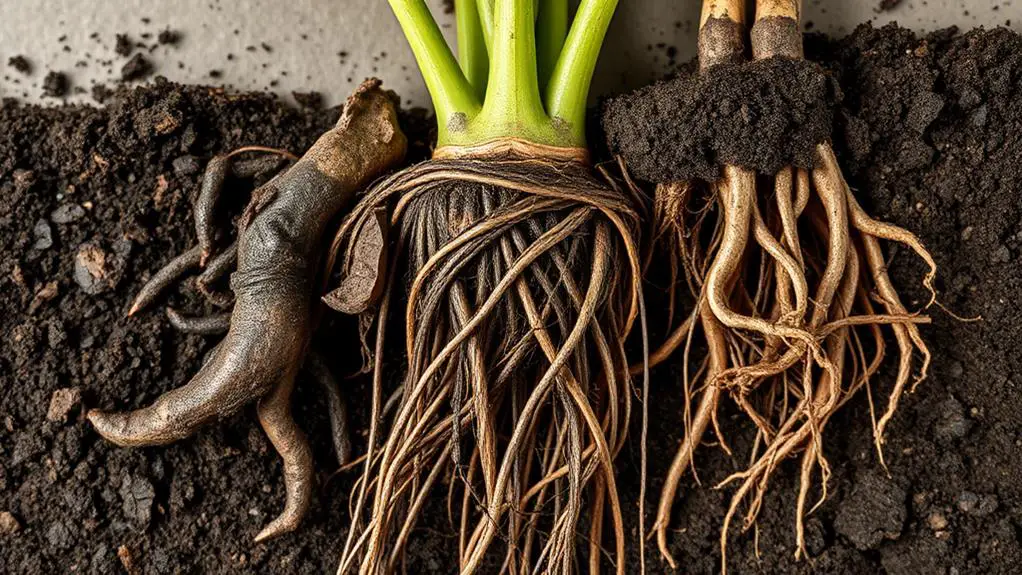
You'll want to check your plant's roots to keep them healthy.
Overwatered plants often suffer from root rot, which you can spot by looking for black, mushy roots that smell bad.
Healthy roots should be firm and white or light tan, so if you see any signs of rot or dryness, take steps to fix the watering right away.
Root Rot Identification
One of the clearest indicators of root rot in plants is the presence of black, mushy roots that emit a foul smell. This happens mainly due to overwatering, which leads to excess moisture around the roots.
When roots are unhealthy, they can't take up water effectively, causing your plant to wilt even if the soil is wet. Healthy roots should be firm and white, so if you notice any brown or slimy roots, it's a strong sign of root rot.
Look for these signs to identify root rot:
- Foul smell coming from the root area.
- Black, mushy roots that are decaying.
- Mold or algae on the soil surface, indicating poor drainage.
- Wilting leaves despite the soil being moist.
- Excess moisture in the pot, creating a damp environment.
To save your plant, you need to act fast. Remove the affected roots and repot the plant in fresh, well-draining soil.
Ascertain the new pot has good drainage to avoid overwatering and prevent future root rot. Remember, healthy roots are key to a thriving plant, so keep an eye on those signs to maintain your plant's root health.
Healthy Root Indicators**
After identifying the warning signs of root rot, it's equally important to know what indicates robust root health. Healthy roots are firm and range from white to light tan in color. They should also smell like fresh soil, signaling good oxygenation and proper moisture levels.
When you see roots that are well-formed and spread throughout the soil, that's a positive sign. These roots can absorb nutrients effectively, keeping your plant nourished.
Guarantee your plant's roots aren't excessively compacted. Compacted roots can hinder nutrient uptake and indicate issues with underwatering or overwatering. If roots start looking mushy and dark, they might be suffering from root rot due to too much water. Healthy roots should be neither too dry nor too wet.
When you're repotting, take the time to inspect the roots closely. They shouldn't be tangled or overly saturated. Consistently healthy roots will help your plant withstand stress from various watering issues.
Fungal Growth
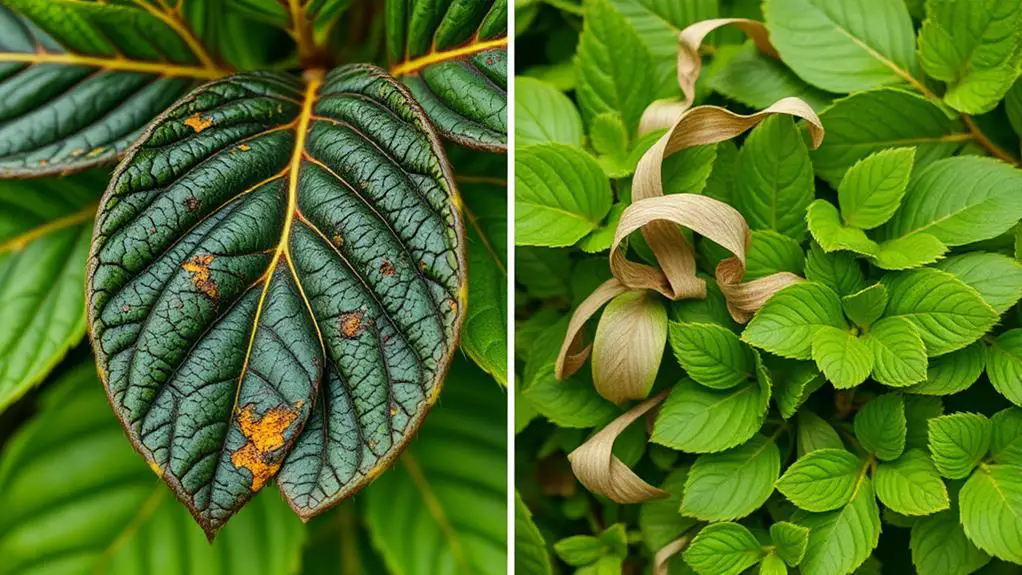
Noticing fungal growth on your plants is a clear sign of overwatering. When your plants are in consistently moist conditions, it's hard for air to circulate properly in the soil. This lack of air circulation creates the perfect environment for fungal pathogens.
You might see white or green mold on the soil and notice a foul smell coming from the pot. These signs are specific to overwatering, as underwatering doesn't provide enough moisture for fungi to thrive.
To prevent fungal growth, keep an eye on your plants and consider these tips:
- Verify your pots have adequate drainage holes to prevent water from pooling.
- Avoid watering at the base of leaves to keep water off the foliage.
- Check your soil moisture before watering to avoid overwatering.
- Improve air circulation around your plants by spacing them properly.
- If you spot fungal growth, consider repotting your plants with fresh soil.
Adjusting your watering practices is essential. Make sure the plants receive the right amount of water without creating soggy conditions.
Frequently Asked Questions
How Can I Tell if I'm Overwatering or Underwatering?
Stick your finger in the soil. If it's soggy, you're overwatering. If it's dry, you're underwatering. Check for yellowing, wilting, or foul odor for overwatering, and dry, crispy edges for underwatering. Pot weight can also help.
Is My Plant Dehydrated or Overwatered?
Feel the soil. If it's soggy, you're overwatering. If it's dry and compacted, your plant's dehydrated. Yellowing, wilting leaves suggest overwatering; dry, crispy edges and drooping leaves point to underwatering. A moisture meter can help too.
How Do You Compare Underwatered and Overwatered Plants?
You can compare by checking soil moisture and leaf condition. Overwatered plants have yellow, soft leaves and soggy soil, while underwatered ones show crispy, brittle leaves and dry soil. Assess quickly to prevent plant stress.
How Do You Tell if a Potted Plant Is Overwatered?
You can tell if a potted plant is overwatered by checking for yellowing leaves, persistent wilting despite wet soil, constantly soggy soil, blisters on leaves, and mold or algae on the soil surface.
Conclusion
You've got this! Remember, by keeping an eye on the signs like yellowing leaves, wilting, and soil condition, you'll be able to figure out if your plant needs more or less water. Don't forget to check for root health and any fungal growth too. With practice, you'll become a pro at spotting what your plants need. Keep caring for your garden, and soon, you'll see them thrive. Happy gardening!

